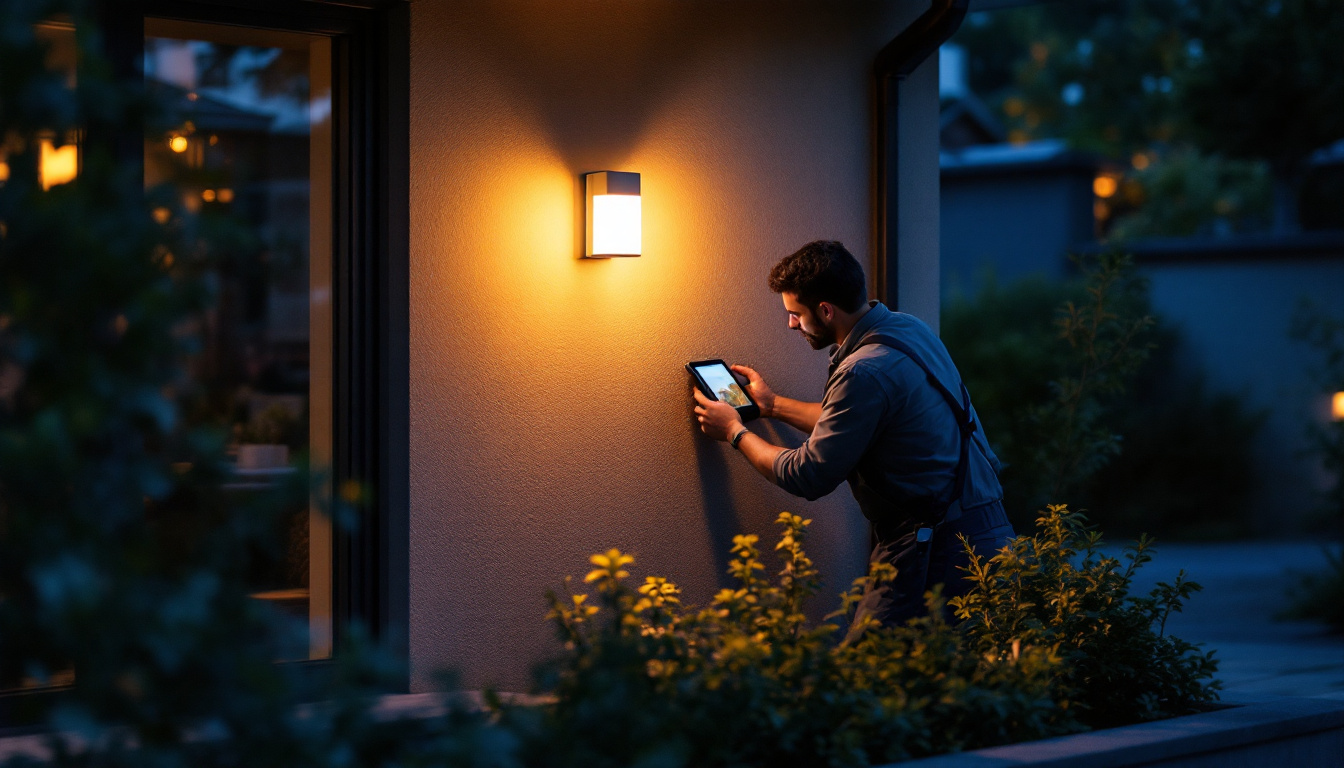
Solar lighting has emerged as a popular choice for various outdoor applications, particularly for illuminating pathways, gardens, and posts. As the demand for sustainable and energy-efficient solutions grows, lighting contractors are increasingly turning to solar-powered options. However, the transition to solar lighting is not without its challenges. Understanding the nuances of solar technology and proper installation can help avoid costly mistakes.
This article aims to provide insights into the essential considerations for lighting contractors when selecting and installing solar lights for posts. By adhering to best practices, contractors can enhance their projects’ efficiency and longevity while ensuring customer satisfaction.
One of the most significant advantages of solar lighting is its ability to harness renewable energy, which not only reduces electricity costs but also minimizes the carbon footprint associated with traditional lighting methods. Solar lights operate by converting sunlight into electricity through photovoltaic cells, which then powers LED bulbs during the night. This technology has advanced considerably, resulting in brighter and more reliable lighting solutions that can function effectively even in less-than-ideal weather conditions. Additionally, many solar lights now come equipped with motion sensors and timers, providing enhanced security and convenience for homeowners and businesses alike.
When selecting solar lights, contractors must consider various factors, including the quality of the solar panels, battery capacity, and the overall design of the fixtures. High-quality solar panels can significantly improve energy absorption, while a robust battery ensures that lights remain operational throughout the night, even on cloudy days. Furthermore, the aesthetic appeal of solar fixtures can play a crucial role in customer satisfaction. With an array of styles and finishes available, contractors should aim to choose designs that complement the surrounding landscape and meet the specific needs of their clients, whether for decorative purposes or functional illumination.
Before diving into the practical aspects of installation, it is crucial to grasp the fundamental technology behind solar lights. Solar lights operate by converting sunlight into electricity through photovoltaic cells. This electricity is then stored in batteries, which power the light during nighttime hours. The efficiency of this conversion process can vary significantly based on the quality of the photovoltaic cells used, as well as the amount of sunlight available in a given location. Therefore, understanding the local climate and typical weather patterns can be essential for optimizing solar lighting systems.
Different types of solar lights are available, each with unique features and applications. Familiarity with these variations will aid contractors in making informed decisions that align with project requirements. For example, some solar lights come equipped with motion sensors, which can enhance security by providing illumination only when movement is detected. This feature not only conserves battery life but also adds an extra layer of safety to outdoor spaces.
Solar lights can be categorized into several types, including solar post lights, path lights, flood lights, and decorative lights. Each type serves a distinct purpose and is designed for specific environments. For instance, solar post lights are ideal for illuminating fences, decks, or garden posts, while solar flood lights are better suited for larger areas that require extensive illumination. Additionally, decorative solar lights can enhance the aesthetic appeal of a garden or patio, providing both functionality and style.
Understanding the specific needs of a project will guide contractors in selecting the appropriate type of solar light. Factors such as brightness, battery capacity, and design should be considered to ensure optimal performance. Furthermore, the placement of these lights is crucial; for example, path lights should be installed at regular intervals to create a safe and inviting walkway, while flood lights should be strategically positioned to cover the widest area possible without causing light pollution.
A solar lighting system comprises several key components: the solar panel, battery, LED light, and controller. Each component plays a vital role in the system’s overall efficiency. The solar panel collects sunlight and converts it into electricity, while the battery stores this energy for later use. The LED light provides illumination, and the controller manages the power flow to ensure the light operates effectively. The integration of smart technology in these systems is also becoming increasingly common, allowing for features such as remote control and programmable settings that can adapt to user preferences.
Contractors should pay close attention to the quality of these components, as they directly impact the performance and durability of the lighting system. Investing in high-quality materials will reduce maintenance costs and enhance customer satisfaction. Additionally, understanding the warranty and support options available for these components can provide peace of mind, ensuring that any potential issues can be addressed promptly. As solar technology continues to evolve, staying informed about the latest advancements can also help contractors offer the best solutions to their clients, ultimately leading to more successful projects and satisfied customers.
Despite the benefits of solar lighting, many contractors encounter pitfalls during installation and selection. Recognizing these common mistakes can help avoid setbacks and ensure successful project outcomes.
One of the most significant mistakes in solar lighting projects is failing to conduct a thorough site assessment. Factors such as sunlight exposure, shading from trees or buildings, and the geographical location can greatly affect a solar light’s performance. Inadequate assessment may lead to insufficient lighting or system failure.
Contractors should evaluate the site during different times of the day to understand how sunlight interacts with the area. This assessment will inform decisions regarding the placement and type of solar lights to be installed.
Another common error is neglecting to consider the battery capacity of solar lights. The battery’s size and quality determine how long the lights will operate at night. If the battery is too small or of poor quality, it may not hold enough charge to power the lights throughout the night, leading to inconsistent performance.
Contractors should choose solar lights with batteries that have adequate capacity for the intended use. Additionally, understanding the average sunlight hours in the project’s location will help in selecting lights that can recharge effectively.
Local regulations and building codes can significantly impact solar lighting installations. Contractors must be aware of any restrictions or requirements that may apply to solar lighting systems in their area. Ignoring these regulations can result in fines, project delays, or even the need to remove installed lights.
Before commencing a project, it is advisable to consult local authorities or building departments to ensure compliance with all relevant codes. This proactive approach will save time and resources in the long run.
To maximize the benefits of solar lighting, contractors should adhere to best practices during the installation process. These practices not only enhance the performance of the lights but also contribute to a smoother project execution.
The placement and orientation of solar lights are critical for optimal performance. Lights should be positioned to receive maximum sunlight exposure throughout the day. This often means placing them in open areas away from obstructions such as trees, buildings, or fences.
Additionally, the angle of the solar panel should be adjusted to capture sunlight effectively, particularly in regions with varying sun angles throughout the year. Proper placement will ensure that the lights receive sufficient charge, leading to reliable nighttime illumination.
Solar lighting systems require minimal maintenance, but regular upkeep is essential to ensure long-term performance. This includes cleaning the solar panels to remove dust and debris that can block sunlight, checking battery health, and replacing any faulty components.
Contractors should educate clients on the importance of maintenance and provide guidelines for keeping the solar lights in optimal condition. By fostering a proactive approach to maintenance, contractors can enhance customer satisfaction and reduce the likelihood of service calls.
In addition to functionality, solar lights can significantly enhance the aesthetic appeal of outdoor spaces. The design and style of solar lights can complement various architectural styles and landscaping themes, making them a versatile choice for contractors.
When selecting solar lights for a project, contractors should consider the overall design and theme of the outdoor space. Options range from sleek modern designs to traditional lantern styles, allowing for customization based on client preferences.
Incorporating solar lights that align with the project’s aesthetic can elevate the visual appeal of the space while providing practical illumination. This attention to detail can set a contractor apart in a competitive market.
Solar lights can be effectively used for landscape lighting, highlighting features such as trees, shrubs, and pathways. By strategically placing solar lights in key areas, contractors can create a captivating ambiance that enhances the outdoor experience.
Utilizing a combination of different types of solar lights can provide layered lighting effects, adding depth and interest to the landscape. Contractors should experiment with placement and design to achieve the desired atmosphere while ensuring functionality.
Solar lighting presents a valuable opportunity for lighting contractors to offer sustainable and energy-efficient solutions to their clients. However, avoiding costly mistakes requires a thorough understanding of solar technology, careful planning, and adherence to best practices.
By conducting comprehensive site assessments, selecting appropriate components, and ensuring compliance with local regulations, contractors can enhance the success of their solar lighting projects. Furthermore, by focusing on aesthetics and maintenance, they can provide clients with a satisfying and long-lasting lighting solution.
As the demand for solar lighting continues to grow, staying informed about the latest trends and technologies will empower contractors to deliver exceptional results, ultimately leading to a successful and sustainable lighting business.
Ready to elevate your lighting projects with the best in solar technology? At LumenWholesale, we provide lighting contractors with top-quality, spec-grade solar lights at unbeatable wholesale prices. Our extensive selection is designed to meet the highest industry standards, ensuring you deliver reliable and high-performance lighting to your clients. Take advantage of our hassle-free bulk buying and enjoy free shipping, giving you the premium lighting solutions you need at the best value — without hidden fees or compromises. Make your next lighting project a shining success with Wholesale Lighting at the Best Value from LumenWholesale.

Explore the pros and cons of HID lighting versus alternative options in this comprehensive guide tailored for lighting contractors.

Explore how home light automation is revolutionizing the industry for lighting contractors.

Discover essential best practices for lighting contractors when it comes to appliance plugs.

Discover how battery-powered external lights are revolutionizing the lighting industry for contractors.